Should We Leave? Attitudes towards Relocation in Response to Sea Level Rise
Abstract
:1. Introduction
2. The Linkages between Risk Experience, Perception, and Mitigation Behavior
3. Hypotheses
4. Methods
4.1. Survey Development and Administration
4.2. Variables and Analytical Procedure
5. Survey Results
5.1. Descriptive Statistics
5.2. Threat Appraisal and Coping Appraisal
5.3. Additional Aspects Regarding Relocation, Action, and Responsibility
5.4. Correlation Analysis
5.5. Multinomial Logit Model
6. Discussion
7. Conclusions
Supplementary Materials
Acknowledgments
Author Contributions
Conflicts of Interest
References
- Liu, W.-C.; Liu, H.-M. Assessing the Impacts of Sea Level Rise on Salinity Intrusion and Transport Time Scales in a Tidal Estuary, Taiwan. Water 2014, 6, 324–344. [Google Scholar] [CrossRef]
- Jevrejeva, S.; Jackson, L.P.; Riva, R.E.; Grinsted, A.; Moore, J.C. Coastal sea level rise with warming above 2 °C. Proc. Natl. Acad. Sci. USA 2016, 113, 13342–13347. [Google Scholar] [CrossRef] [PubMed]
- Kousky, C. Managing shoreline retreat: A US perspective. Clim. Chang. 2014, 124, 9–20. [Google Scholar] [CrossRef]
- The Intergovernmental Panel on Climate Change. Summary for Policymakers. In Climate Change 2013: The Physical Science Basis, Contribution of Working Group I to the Fifth Assessment Report of the Intergovernmental Panel on Climate Change; Stocker, T.F., Solomon, S., Qin, D., Manning, M., Chen, Z., Marquis, M., Averyt, K.B., Tignor, M., Mille, H.L., Eds.; Cambridge University Press: Cambridge, UK; New York, NY, USA, 2013; pp. 1–30. [Google Scholar]
- Per, B. The Bruun Rule of Erosion by Sea-Level Rise: A Discussion on Large-Scale Two- and Three-Dimensional Usages. J. Coast. Res. 1988, 4, 627–648. [Google Scholar]
- Song, J.; Fu, X.; Wang, R.; Peng, Z.-R.; Gu, Z. Does planned retreat matter? Investigating land use change under the impacts of flooding induced by sea level rise. Mitig. Adapt. Strateg. Glob. Chang. 2017. [Google Scholar] [CrossRef]
- Chinh, D.T.; Gain, A.K.; Dung, N.V.; Haase, D.; Kreibich, H. Multi-Variate Analyses of Flood Loss in Can Tho City, Mekong Delta. Water 2016, 8, 6. [Google Scholar] [CrossRef]
- Werner, A.D.; Simmons, C.T. Impact of Sea-Level Rise on Sea Water Intrusion in Coastal Aquifers. Ground Water 2009, 47, 197–204. [Google Scholar] [CrossRef] [PubMed]
- Luoma, S.; Okkonen, J. Impacts of Future Climate Change and Baltic Sea Level Rise on Groundwater Recharge, Groundwater Levels, and Surface Leakage in the Hanko Aquifer in Southern Finland. Water 2014, 6, 3671–3700. [Google Scholar] [CrossRef]
- Pickaver, A.H.; Gilbert, C.; Breton, F. An indicator set to measure the progress in the implementation of integrated coastal zone management in Europe. Ocean Coast. Manag. 2004, 47, 449–462. [Google Scholar] [CrossRef]
- Smajgl, A.; Toan, T.Q.; Nhan, D.K.; Ward, J.; Trung, N.H.; Tri, L.Q.; Tri, V.P.D.; Vu, P.T. Responding to rising sea levels in the Mekong Delta. Nat. Clim. Chang. 2015, 5, 167–174. [Google Scholar] [CrossRef]
- Nicholls, R.J.; Marinova, N.; Lowe, J.A.; Brown, S.; Vellinga, P.; de Gusmão, D.; Hinkel, J.; Tol, R.S.J. Sea-level rise and its possible impacts given a ‘beyond 4 degrees C world’ in the twenty-first century. Philos. Trans. R. Soc. A Math. Phys. Eng. Sci. 2011, 369, 161–181. [Google Scholar] [CrossRef] [PubMed]
- Amos, E.; Akpan, U.; Ogunjobi, K. Households’ perception and livelihood vulnerability to climate change in a coastal area of Akwa Ibom State, Nigeria. Environ. Dev. Sustain. 2015, 17, 887–908. [Google Scholar] [CrossRef]
- Lo, A.Y. The role of social norms in climate adaptation: Mediating risk perception and flood insurance purchase. Glob. Environ. Chang. Hum. Policy Dimens. 2013, 23, 1249–1257. [Google Scholar] [CrossRef]
- Boyer-Villemaire, U.; Bernatchez, Z.; Benavente, J.; Cooper, J.A.G. Quantifying community’s functional awareness of coastal changes and hazards from citizen perception analysis in Canada, UK and Spain. Ocean Coast. Manag. 2014, 93, 106–120. [Google Scholar] [CrossRef]
- Harries, T. The anticipated emotional consequences of adaptive behaviour-impacts on the take-up of household flood-protection measures. Environ. Plan. A 2012, 44, 649–668. [Google Scholar] [CrossRef]
- Soetanto, R.; Mullins, A.; Achour, N. The perceptions of social responsibility for community resilience to flooding: The impact of past experience, age, gender and ethnicity. Nat. Hazards 2017, 86, 1105–1126. [Google Scholar] [CrossRef]
- Lo, A.Y.; Chan, F. Preparing for flooding in England and Wales: The role of risk perception and the social context in driving individual action. Nat. Hazards 2017, 88, 367–387. [Google Scholar] [CrossRef]
- Taylor, A.; de Bruin, W.B.; Dessai, S. Climate Change Beliefs and Perceptions of Weather-Related Changes in the United Kingdom. Risk Anal. 2014, 34, 1995–2004. [Google Scholar] [CrossRef] [PubMed]
- Demski, C.; Capstick, S.; Pidgeon, N.; Sposato, R.G.; Spence, A. Experience of extreme weather affects climate change mitigation and adaptation responses. Clim. Chang. 2017, 140, 149–164. [Google Scholar] [CrossRef]
- Rogers, R.W. Cognitive and psychological processes in fear appeals and attitude change: A revised theory of protection motivation. In Social Psychophysiology: A Sourcebook; Guilford: New York, NY, USA, 1983; pp. 153–176. [Google Scholar]
- De Man, A.; Simpson-Housley, P. Correlates of Responses to Two Potential Hazards. J. Soc. Psychol. 1988, 128, 385–391. [Google Scholar] [CrossRef] [PubMed]
- Kumagai, Y.; Carroll, M.S.; Cohn, P. Coping with Interface Wildfire as a Human Event: Lessons from the Disaster/Hazards Literature. J. For. 2004, 102, 28–32. [Google Scholar]
- Kievik, M.; Gutteling, J.M. Yes, we can: Motivate Dutch citizens to engage in self-protective behavior with regard to flood risks. Nat. Hazards 2011, 59, 1475–1490. [Google Scholar] [CrossRef]
- Guion, D.T.; Scammon, D.L.; Borders, A.L. Weathering the Storm: A Social Marketing Perspective on Disaster Preparedness and Response with Lessons from Hurricane Katrina. J. Public Policy Mark. 2007, 26, 20–32. [Google Scholar] [CrossRef]
- Frondel, M.; Simora, M.; Sommer, S. Risk Perception of Climate Change: Empirical Evidence for Germany. Ecol. Econ. 2017, 137, 173–183. [Google Scholar] [CrossRef]
- Ling, F.H.; Tamura, M.; Yasuhara, K.; Ajima, K.; Van Trinh, C. Reducing flood risks in rural households: Survey of perception and adaptation in the Mekong delta. Clim. Chang. 2015, 132, 209–222. [Google Scholar] [CrossRef]
- Lawrence, J.; Quade, D.; Becker, J. Integrating the effects of flood experience on risk perception with responses to changing climate risk. Nat. Hazards 2014, 74, 1773–1794. [Google Scholar] [CrossRef]
- Scolobig, A.; De Marchi, B.; Borga, M. The missing link between flood risk awareness and preparedness: Findings from case studies in an Alpine Region. Nat. Hazards 2012, 63, 499–520. [Google Scholar] [CrossRef]
- Grothmann, T.; Reusswig, F. People at risk of flooding: Why some residents take precautionary action while others do not. Nat. Hazards 2006, 38, 101–120. [Google Scholar] [CrossRef]
- Begg, C.; Christian, K.; Maximilian, U.; Torsten, M. Interactions between citizen responsibilization, flood experience and household resilience: Insights from the 2013 flood in Germany. Int. J. Water Resour. Dev. 2017, 33, 591–608. [Google Scholar] [CrossRef]
- Zheng, Y.; Dallimer, M. What motivates rural households to adapt to climate change? Clim. Dev. 2016, 8, 110–121. [Google Scholar] [CrossRef]
- Werg, J.; Grothmann, T.; Schmidt, P.; Werg, J.; Grothmann, T.; Schmidt, P. Assessing social capacity and vulnerability of private households to natural hazards—Integrating psychological and governance factors. Nat. Hazards Earth Syst. Sci. 2013, 13, 1613–1628. [Google Scholar] [CrossRef]
- Koerth, J.; Vafeidis, A.T.; Hinkel, J.; Sterr, H. What motivates coastal households to adapt pro-actively to sea-level rise and increasing flood risk? Reg. Environ. Chang. 2013, 13, 897–909. [Google Scholar] [CrossRef]
- Renn, O. The social amplification/attenuation of risk framework: Application to climate change. Clim. Chang. 2011, 2, 154–169. [Google Scholar] [CrossRef]
- Grothmann, T.; Patt, A. Adaptive capacity and human cognition: The process of individual adaptation to climate change. Glob. Environ. Chang. 2005, 15, 199–213. [Google Scholar] [CrossRef]
- Ruddell, D.; Harlan, S.L.; Grossman-Clarke, S.; Chowell, G. Scales of perception: Public awareness of regional and neighborhood climates. Clim. Chang. 2012, 111, 581–607. [Google Scholar] [CrossRef]
- McLennan, J.; Every, D.; Bearman, C.; Wright, L. On the concept of denial of natural hazard risk and its use in relation to householder wildfire safety in Australia. Int. J. Disaster Risk Reduct. 2017, 21, 176–186. [Google Scholar] [CrossRef]
- Elrick-Barr, C.; Glavovic, B.; Kay, R. A tale of two atoll nations: A comparison of risk, resilience, and adaptive response of Kiribati and the Maldives. In Climate Change and the Coast; CRC Press: Boca Raton, FL, USA, 2015; pp. 313–336. [Google Scholar]
- Barnett, J.; Fincher, R.; Hurlimann, A.; Graham, S.; Mortreux, C. Equitable Local Outcomes in Adaptation to Sea-Level Rise: Final Project Report; The University of Melbourne: Melbourne, Australia, 2014. [Google Scholar]
- Shao, W.; Xian, S.; Keim, B.D.; Goidel, K.; Lin, N. Understanding perceptions of changing hurricane strength along the US Gulf coast. Int. J. Climatol. 2017, 37, 1716–1727. [Google Scholar] [CrossRef]
- Bukvic, A.; Owen, G. Attitudes towards relocation following Hurricane Sandy: Should we stay or should we go? Disasters 2017, 41, 101–123. [Google Scholar] [CrossRef] [PubMed]
- Bubeck, P.; Botzen, W.J.; Aerts, J.C. A review of risk perceptions and other factors that influence flood mitigation behavior. Risk Anal. 2012, 32, 1481–1495. [Google Scholar] [CrossRef] [PubMed] [Green Version]
- Hurricane City. The History with Tropical Systems in Panama City, Florida. 2017. Available online: http://www.hurricanecity.com/city/panamacity.htm (accessed on 10 November 2017).
- Kettle, N.P.; Dow, K. Comparing Coastal Planner Expectations of Change to Climate Science Projections. J. Environ. Policy Plan. 2015, 17, 475–494. [Google Scholar] [CrossRef]
- Koerth, J.; Jones, N.; Vafeidis, A.T.; Dimitrakopoulos, P.G.; Melliou, A.; Chatzidimitriou, E.; Koukoulas, S. Household adaptation and intention to adapt to coastal flooding in the Axios—Loudias—Aliakmonas National Park, Greece. Ocean Coast. Manag. 2013, 82, 43–50. [Google Scholar] [CrossRef]
- Richard, J.T.K.; Robert, J.N.; Sachooda, R.; Michele, C.; James, A.; Earle, N.B. Technological Options for Adaptation to Climate Change in Coastal Zones. J. Coast. Res. 2001, 17, 531–543. [Google Scholar]
- U.S. Census Bureau. Total Population in Bay County. 2015. Available online: http://factfinder.census.gov/faces/tableservices/jsf/pages/productview.xhtml?pid=DEC_10_SF1_P1&prodType=table (accessed on 8 June 2015).
- Graham, S.; Barnett, J.; Fincher, R.; Hurlimann, A.; Mortreux, C. Local values for fairer adaptation to sea-level rise: A typology of residents and their lived values in Lakes Entrance, Australia. Glob. Environ. Chang. 2014, 29, 41–52. [Google Scholar] [CrossRef]
- Norris, F.H.; Smith, T.; Kaniasty, K. Revisiting the Experience-Behavior Hypothesis: The Effects of Hurricane Hugo on Hazard Preparedness and Other Self-Protective Acts. Basic Appl. Soc. Psychol. 1999, 21, 37–47. [Google Scholar]
- Cutter, S.L.; Boruff, B.J.; Shirley, W.L. Social vulnerability to environmental hazards. Soc. Sci. Q. 2003, 84, 242–261. [Google Scholar] [CrossRef]
- Tobin, G.A.; Whiteford, L.M.; Jones, E.C.; Murphy, A.D.; Garren, S.J.; Padros, C.V. The role of individual well-being in risk perception and evacuation for chronic vs. acute natural hazards in Mexico. Appl. Geogr. 2011, 31, 700–711. [Google Scholar] [CrossRef]
- Ludy, J.; Kondolf, G.M. Flood risk perception in lands “protected” by 100-year levees. Nat. Hazards 2012, 61, 829–842. [Google Scholar] [CrossRef]
- Cigler, B.A. The “Big Questions” of Katrina and the 2005 great flood of New Orleans. Public Adm. Rev. 2007, 67, 64–76. [Google Scholar] [CrossRef]
- Fincher, R.; Barnett, J.; Graham, S.; Hurlimann, A. Time stories: Making sense of futures in anticipation of sea-level rise. Geoforum 2014, 56, 201–210. [Google Scholar] [CrossRef]
- Burningham, K.; Fielding, J.; Thrush, D. ‘It’ll never happen to me’: Understanding public awareness of local flood risk. Disasters 2008, 32, 216–238. [Google Scholar] [CrossRef] [PubMed]
- Zaalberg, R.; Midden, C.; Meijnders, A.; McCalley, T. Prevention, Adaptation, and Threat Denial: Flooding Experiences in the Netherlands. Risk Anal. 2009, 29, 1759–1778. [Google Scholar] [CrossRef] [PubMed]
- Adger, W.N.; Barnett, J.; Brown, K.; Marshall, N.; O’Brien, K. Cultural dimensions of climate change impacts and adaptation. Nat. Clim. Chang. 2012, 3, 112–117. [Google Scholar] [CrossRef]
- Kirwan, M.L.; Megonigal, J.P. Tidal wetland stability in the face of human impacts and sea-level rise. Nature 2013, 504, 53–60. [Google Scholar] [CrossRef] [PubMed]
- Pulido-Leboeuf, P. Seawater intrusion and associated processes in a small coastal complex aquifer (Castell de Ferro, Spain). Appl. Geochem. 2004, 19, 1517–1527. [Google Scholar] [CrossRef]
- Becker, S.L.; Reusser, D.E. Disasters as opportunities for social change: Using the multi-level perspective to consider the barriers to disaster-related transitions. Int. J. Disaster Risk Reduct. 2016, 18, 75–88. [Google Scholar] [CrossRef]
- Maly, E.; Kondo, T.; Banba, M. Experience from the United States: Post-Katrina and Sandy. In Land Use Management in Disaster Risk Reduction: Practice and Cases from a Global Perspective; Banba, M., Shaw, R., Eds.; Springer: Japan, Tokyo, 2017; pp. 79–106. [Google Scholar]
- Ajzen, I.; Fishbein, M. Understanding Attitudes and Predicting Social Behavior; Prentice-Hall: Upper Saddle River, NJ, USA, 1980. [Google Scholar]

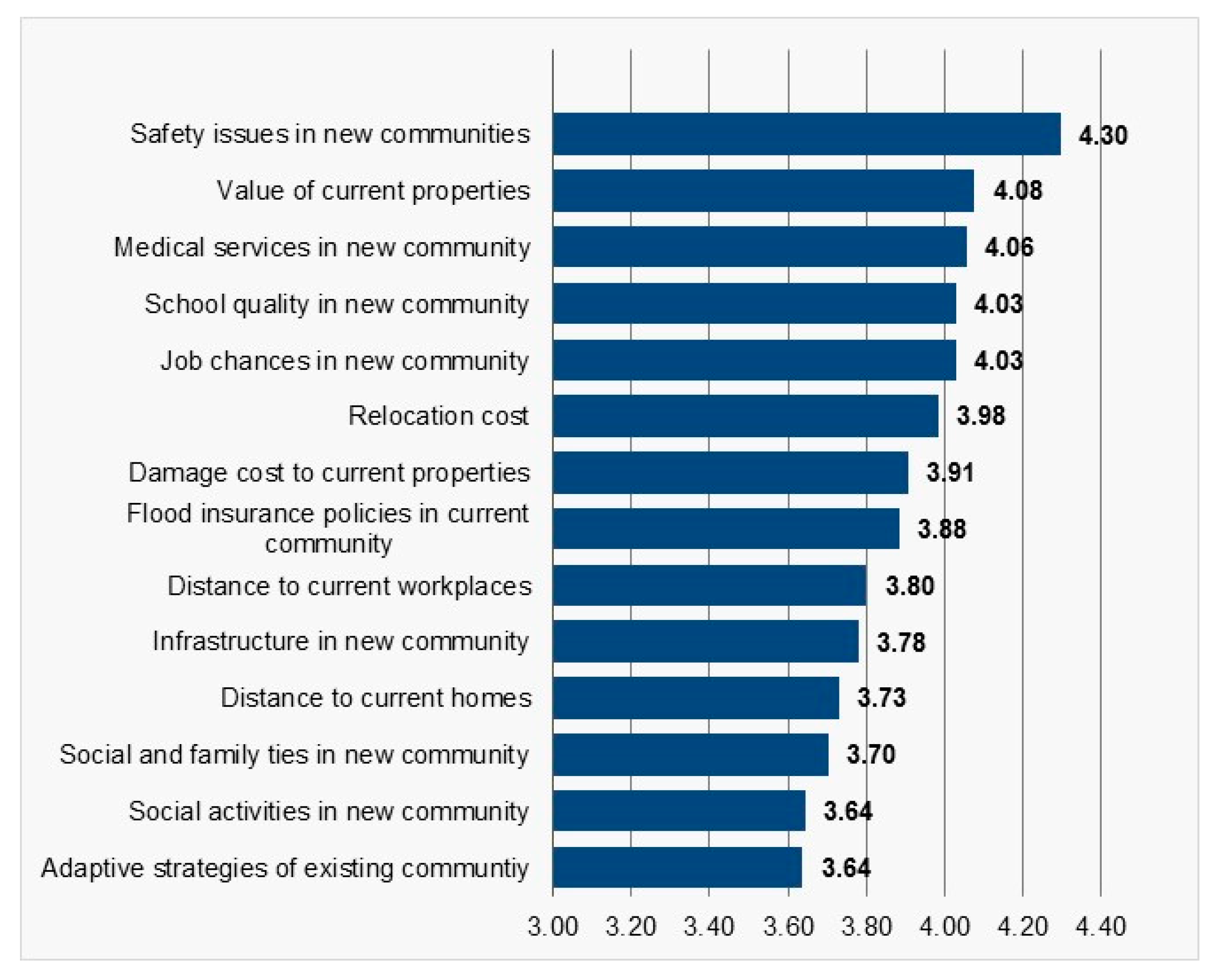
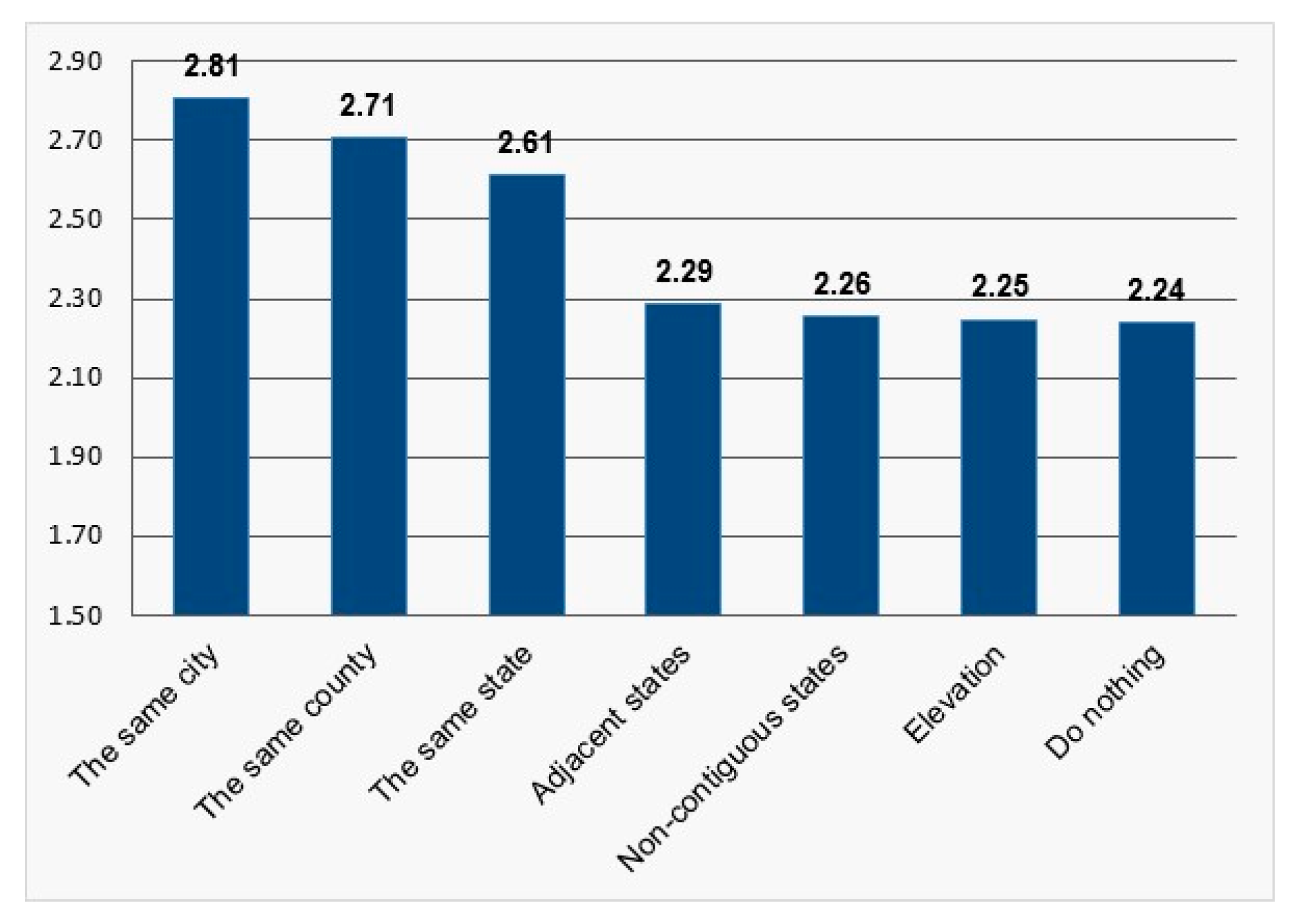
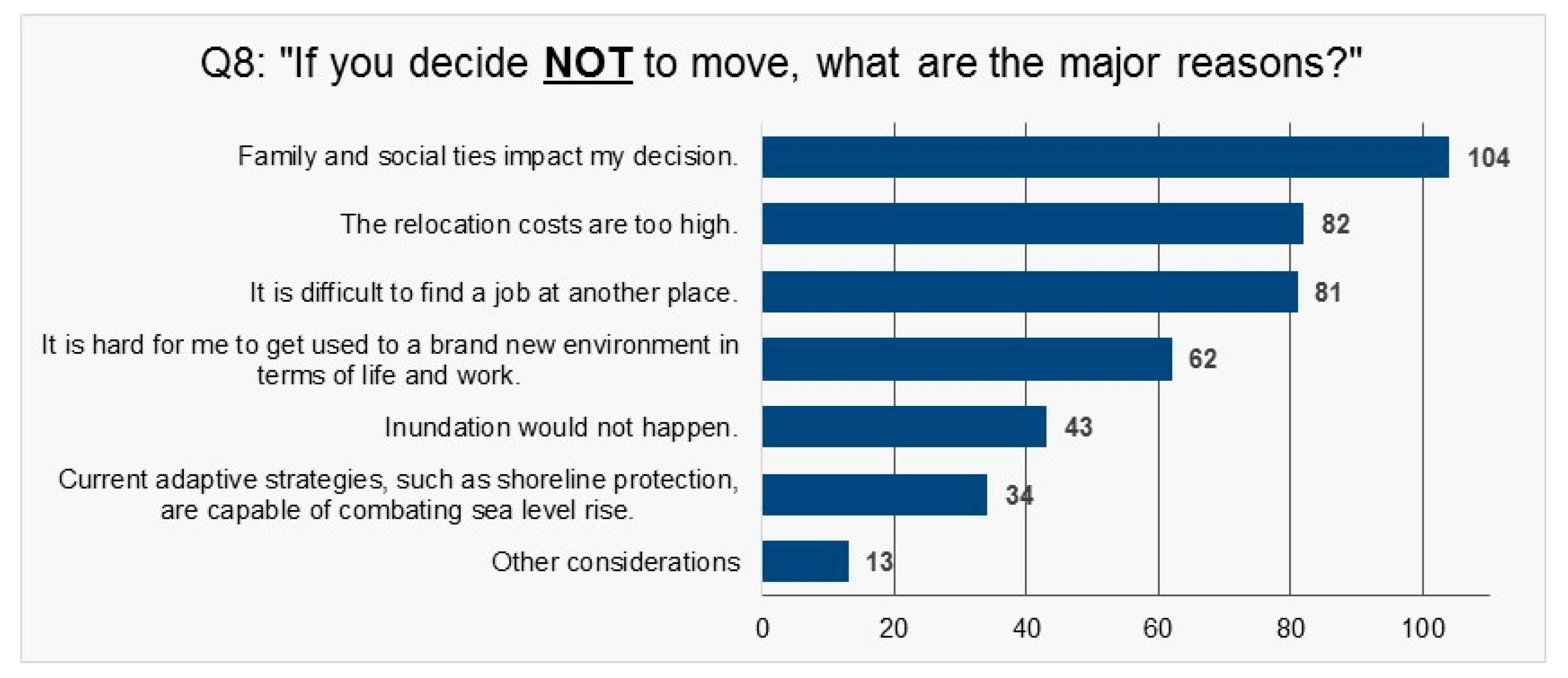
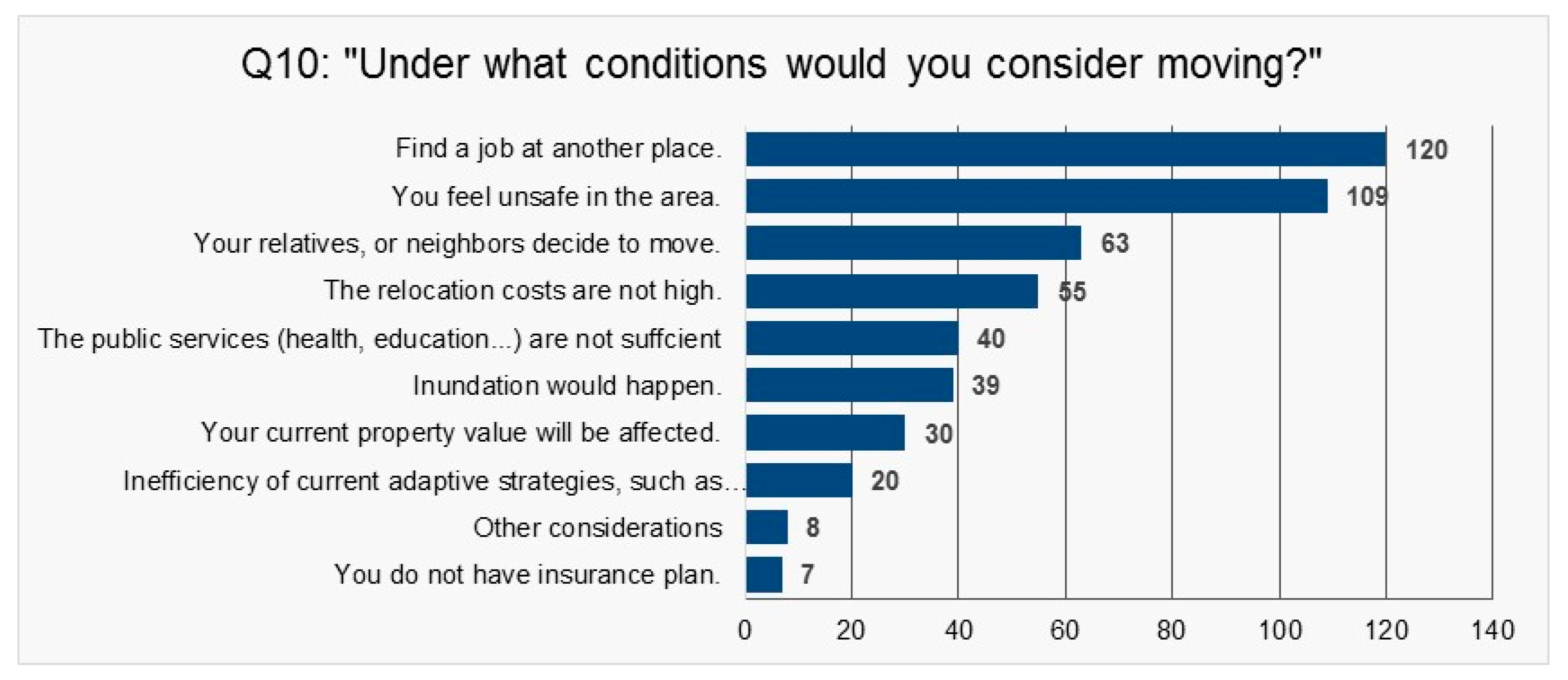
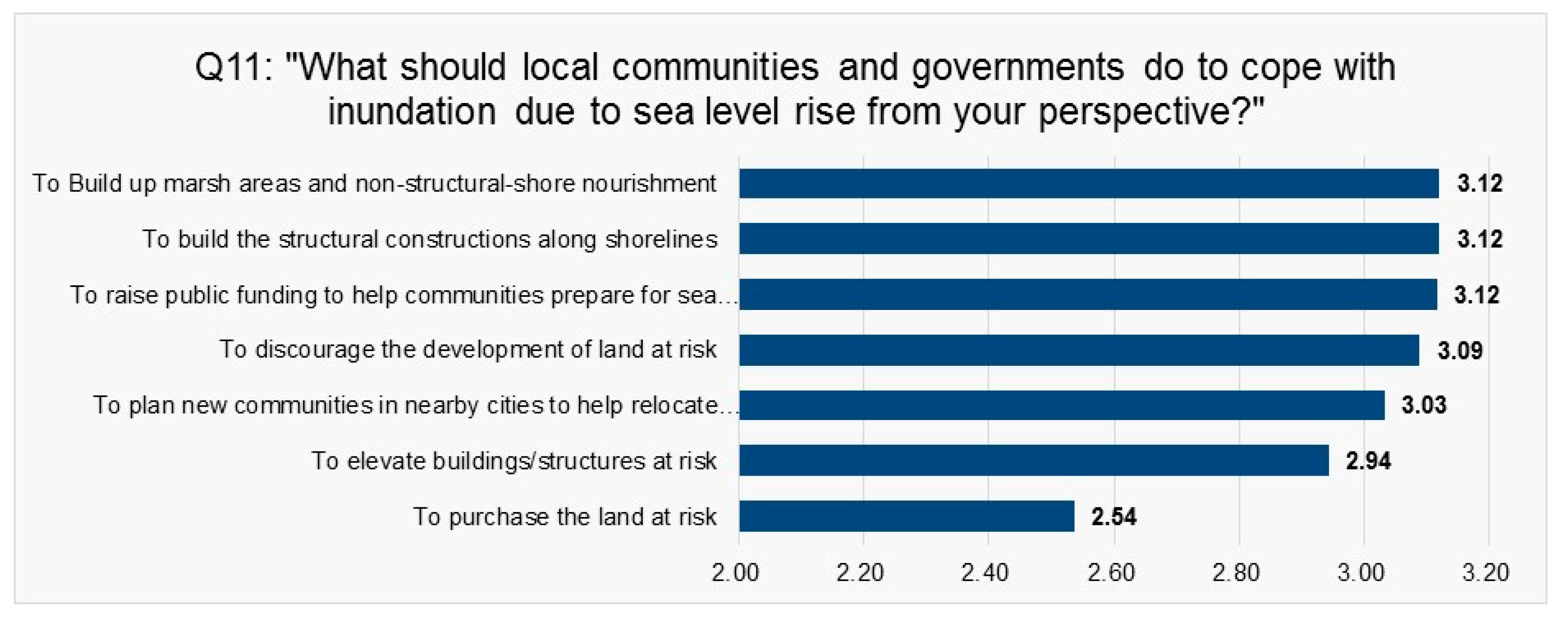
| Category | Description | Coding Scheme |
|---|---|---|
| Risk perception | To what degree do you agree with the fact that sea level rise is occurring? | Likert Scale: 1–5 |
| To what degree do you consider sea level rise as a threat to our future natural environment? | 5-point scale: 1 (not serious at all) to 5 (very serious) | |
| To what degree do you consider sea level rise as a threat to our built environment? | ||
| Do you believe that sea level rise intensifies extreme weather events, e.g., floods, hurricanes and storm surges, etc.? | Binary scale: 1 (yes), 0 (no) | |
| Hazard experience | Have you experienced any damage due to the following extreme weather events? Flooding Extreme precipitation Hurricane Other disasters | Binary scale: 1 (yes), 0 (no) |
| Coping/adaptation appraisal | To what extent can each of the following factors affect your decision to move or not? Job opportunities of new communities The distance of new communities to current work places The distance of new communities to current primary home residence Infrastructure quality of new communities School quality of new communities Health care services of new communities Social and family ties of new communities Social activities within new communities Safety issues like crime rates in new communities Relocation costs | 5-point scale: 1 (not important at all) to 5 (very important) |
| Threat appraisal | To what extent can each of the following factors affect your decision to move or not? Current adaptation strategies including seawalls, sand dunes, and marshes Cost of damage to existing homes Flooding insurance policies of existing communities The value of your existing properties | 5-point scale: 1 (not important at all) to 5 (very important) |
| Threat appraisal | Under what conditions would you consider moving? Inundation would happen | Binary scale: 1 (yes), 0 (no) |
| Social Influence | Under what conditions would you consider moving? Your family, relatives, or neighbors decide to move | Binary scale: 1 (yes), 0 (no) |
| The following variables were not included in the correlation and Logit modeling analysis. | ||
| Relocation destinations | Please rate the preference of the following places where you would move? Move inland but in the same city Move out of the city but in the same county Move out of the county but within the same state Move into an adjacent state Move into a non-contiguous state Elevate existing house Do nothing | 5-point scale: 1 (least preferred) to 5 (most preferred) |
| Motivation of inaction and relocation, and the shift of responsibility |
| Measurements with binary scale: 1 (yes) or 0 (no) |
| 1 | 2 | 3 | 4 | 5 | 6 | 7 | 8 | 9 | 10 | |
|---|---|---|---|---|---|---|---|---|---|---|
| 1 Relocation response | - | |||||||||
| 2 Sea level rise fact | 0.235 *** | - | ||||||||
| 3 Sea level rise and disaster | 0.297 *** | 0.149 ** | - | |||||||
| 4 Sea level rise and natural environment | −0.440 *** | −0.208 *** | −0.382 *** | - | ||||||
| 5 Sea level rise and built environment | −0.368 *** | −0.196 *** | −0.320 *** | 0.745 *** | - | |||||
| 6 Flood experience | 0.055 | 0.100 | 0.105 | −0.031 | −0.095 | - | ||||
| 7 Extreme precipitation experience | 0.014 | 0.056 | 0.060 | 0.024 | −0.033 | 0.072 | - | |||
| 8 Hurricane experience | −0.010 | 0.045 | −0.100 | 0.095 | 0.096 | 0.021 | 0.049 | - | ||
| 9 Storm Surge experience | 0.077 | 0.139 | 0.032 | −0.133 | −0.079 | 0.150 ** | 0.016 | 0.183 ** | - | |
| 10 Other hazard experience | −0.148 ** | −0.063 | −0.119 | 0.041 | 0.088 | −0.101 | −0.118 | −0.138 | −0.110 | - |
| 1 | 11 | 12 | 13 | 14 | 15 | 16 | 17 | 18 | 19 | 20 | 21 | 22 | 23 | 24 | 25 | 26 | |
|---|---|---|---|---|---|---|---|---|---|---|---|---|---|---|---|---|---|
| 1 Relocation response | - | ||||||||||||||||
| 11 Job chances in new community | 0.036 | - | |||||||||||||||
| 12 Distance to current workplace | 0.061 | 0.503 *** | - | ||||||||||||||
| 13 Distance to home | 0.111 | 0.344 *** | 0.794 *** | - | |||||||||||||
| 14 Facility | 0.131 | 0.400 *** | 0.348 *** | 0.391 *** | - | ||||||||||||
| 15 School | 0.026 | 0.370 *** | 0.416 *** | 0.435 *** | 0.481 *** | - | |||||||||||
| 16 Medical service | 0.075 | 0.307 *** | 0.343 *** | 0.343 *** | 0.489 *** | 0.544 *** | - | ||||||||||
| 17 Social ties | 0.088 | 0.206 *** | 0.277 *** | 0.367 *** | 0.422 *** | 0.444 *** | 0.404 *** | - | |||||||||
| 18 Social activities | 0.123 | 0.282 *** | 0.263 *** | 0.285 *** | 0.382 *** | 0.354 *** | 0.393 *** | 0.512 *** | - | ||||||||
| 19 Relocation cost | 0.124 | 0.373 *** | 0.401 *** | 0.399 *** | 0.363 *** | 0.344 *** | 0.322 *** | 0.321 *** | 0.250 *** | - | |||||||
| 20 Safety of new community | 0.035 | 0.310 *** | 0.350 *** | 0.337 *** | 0.438 *** | 0.461 *** | 0.529 *** | 0.322 *** | 0.236 *** | 0.471 *** | - | ||||||
| 21 Adaptation strategies of current community | 0.075 | 0.137 | 0.299 *** | 0.376 *** | 0.457 *** | 0.338 *** | 0.485 *** | 0.485 *** | 0.419 *** | 0.360 *** | 0.371 *** | - | |||||
| 22 Damage cost | 0.189 *** | 0.305 *** | 0.315 *** | 0.337 *** | 0.537 *** | 0.359 *** | 0.510 *** | 0.504 *** | 0.319 *** | 0.557 *** | 0.456 *** | 0.583 *** | - | ||||
| 23 Existing flood insurance | 0.051 | 0.260 *** | 0.310 *** | 0.398 *** | 0.539 *** | 0.358 *** | 0.453 *** | 0.436 *** | 0.344 *** | 0.452 *** | 0.396 *** | 0.571 *** | 0.728 *** | - | |||
| 24 Current property value | 0.119 | 0.295 *** | 0.307 *** | 0.328 *** | 0.456 *** | 0.345 *** | 0.452 *** | 0.358 *** | 0.243 *** | 0.448 *** | 0.424 *** | 0.358 *** | 0.544 *** | 0.562 *** | - | ||
| 25 Inundation is inevitable | 0.010 | −0.102 | −0.152 ** | −0.166 ** | −0.086 | −0.191 *** | −0.010 | −0.070 | 0.004 | −0.128 | −0.079 | −0.080 | −0.041 | −0.079 | −0.049 | - | |
| 26 Neighbor’s action | 0.024 | 0.014 | 0.071 | 0.076 | 0.107 | 0.092 | 0.129 | 0.227 *** | 0.126 | 0.106 | 0.208 *** | 0.148 ** | 0.069 | 0.029 | 0.030 | −0.024 | - |
| Variables | Not Sure | Will Relocate | ||
|---|---|---|---|---|
| Parameter | t-Statistic | Parameter | t-Statistic | |
| Constant | 1.704 | 2.786 | 1.050 | 3.225 |
| Risk perception and hazard experience | ||||
| Sea level rise is occurring | 0.521 * | 0.273 | 0.737 ** | 0.295 |
| Sea level rise and hazards | 0.608 | 0.625 | 1.516 ** | 0.673 |
| Sea lever rise and natural environment | −0.756 * | 0.450 | −1.279 ** | 0.491 |
| Hazard experience (other types) | −1.081 | 1.009 | −3.681 ** | 1.536 |
| Threat and coping appraisal | ||||
| Adaptation strategies of existing communities (sea walls and beach nourishment) | −0.679 | 0.424 | −0.789 * | 0.476 |
| Flood insurance police of existing community | 0.028 | 0.499 | −1.118 ** | 0.555 |
| Cost damage to existing homes | 0.598 | 0.587 | 1.684 ** | 0.667 |
| Household-level characteristics | ||||
| Age between 18 and 45 | −1.511 ** | 0.715 | −1.318 * | 0.783 |
| High school graduate or less | −1.846 * | 1.092 | −2.409 ** | 1.141 |
| College degree | −1.244 | 1.010 | −1.963 * | 1.074 |
| Male | 0.099 | 0.616 | 1.166 * | 0.653 |
| American African | 1.731 | 1.817 | 4.300 ** | 1.973 |
| Log likelihood | ||||
| Convergence | −140.118 | |||
| Constant only | −213.150 | |||
| Number of observations | 196 | |||
© 2017 by the authors. Licensee MDPI, Basel, Switzerland. This article is an open access article distributed under the terms and conditions of the Creative Commons Attribution (CC BY) license (http://creativecommons.org/licenses/by/4.0/).
Share and Cite
Song, J.; Peng, B. Should We Leave? Attitudes towards Relocation in Response to Sea Level Rise. Water 2017, 9, 941. https://doi.org/10.3390/w9120941
Song J, Peng B. Should We Leave? Attitudes towards Relocation in Response to Sea Level Rise. Water. 2017; 9(12):941. https://doi.org/10.3390/w9120941
Chicago/Turabian StyleSong, Jie, and Binbin Peng. 2017. "Should We Leave? Attitudes towards Relocation in Response to Sea Level Rise" Water 9, no. 12: 941. https://doi.org/10.3390/w9120941





